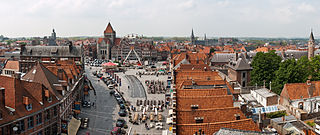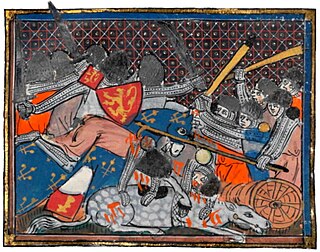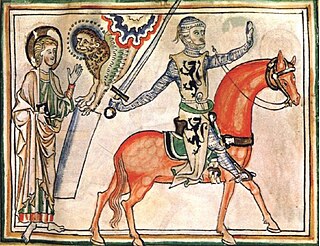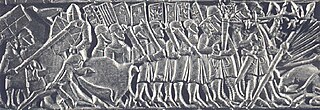
Tournai or Tournay is a city and municipality of Wallonia located in the Province of Hainaut, Belgium. It lies 89 km (55 mi) by road southwest of the centre of Brussels on the river Scheldt, and is part of Eurometropolis Lille–Kortrijk–Tournai, In 2022, the municipality of Tournai had an estimated population of 68,518 people.

The Battle of the Golden Spurs was a military confrontation between the royal army of France and rebellious forces of the County of Flanders on 11 July 1302 during the Franco-Flemish War (1297–1305). It took place near the town of Kortrijk (Courtrai) in modern-day Belgium and resulted in an unexpected victory for the Flemish. It is sometimes referred to as the Battle of Courtrai.
John II was Count of Hainaut, Holland, and Zeeland.

Guy of Dampierre was the Count of Flanders (1251–1305) and Marquis of Namur (1264–1305). He was a prisoner of the French when his Flemings defeated the latter at the Battle of the Golden Spurs in 1302.

The Battle of Roosebeke took place on 27 November 1382 on the Goudberg between a Flemish army under Philip van Artevelde and a French army under Louis II of Flanders who had called upon the help of the French king Charles VI after he had suffered a defeat during the Battle of Beverhoutsveld. The Flemish army was defeated, Philip van Artevelde was slain and his corpse was put on display.
The siege of Tournai may refer to:

The Battle of Saint-Omer, fought on 26 July 1340, was a major engagement in the early stages of the Hundred Years' War, during Edward III's 1340 summer campaign against France launched from Flanders. The campaign was initiated in the aftermath of the English naval victory at the Battle of Sluys but was far less successful than Edward had hoped. At Saint-Omer, the heavily-outnumbered French men-at-arms, tasked with defending the city and awaiting reinforcements, unexpectedly defeated the Anglo-Flemish forces on their own. The allies suffered heavy losses and the French captured their camp intact, taking many warhorses, draft animals and carts, all the tents, huge quantities of supplies and most of the Flemish standards. Edward's campaign of 1340 had begun badly. On the bright side, the loss of several thousand men was bearable, as the survivors, which included most of the precious English longbowmen, eventually rejoined him at Tournai. The defeat had serious strategic consequences. It exposed southern Flanders to the wrath of Philip VI and enabled the French to concentrate their forces against the main army of the coalition in the siege of Tournai.

William of Jülich, called the Younger, was one of the Flemish noblemen that opposed the annexation policies of the French king Philip IV, together with Pieter de Coninck.
The Day of the Flemish Community of Belgium is an annual commemoration in the Flemish Community in Belgium on 11 July which marks the anniversary of the Battle of the Golden Spurs (Guldensporenslag) in 1302.
The development of urban centres in the Low Countries shows the process by which the Low Countries, a region in Western Europe, evolved from a highly rural outpost of the Roman Empire into the largest urbanised area north of the Alps by the 15th century CE. As such, this article covers the development of Dutch and Flemish cities beginning at the end of the migration period till the end of the Dutch Golden Age.

Kortrijk, sometimes known in English as Courtrai or Courtray, is a Belgian city and municipality in the Flemish province of West Flanders.

The battle of Zierikzee was a naval battle between a Flemish fleet and an allied Franco-Hollandic fleet which took place on 10 and 11 August 1304. The battle, fought near the town of Zierikzee, ended in a Franco-Dutch victory. The battle is part of a larger conflict between the Count of Flanders and his French feudal lord, King Philip IV of France (1296–1305).

On 23 August 1328, the Battle of Cassel took place near the city of Cassel, 30 km south of Dunkirk in present-day France. Philip VI fought Nicolaas Zannekin, a wealthy farmer from Lampernisse. Zannekin was the leader of a band of Flemish rebels. The fighting erupted over taxation and punitive edicts of the French over the Flemish. The battle was won decisively by the French. Zannekin and about 3,200 Flemish rebels were killed in the battle.

The siege of Tournai occurred during the Edwardian phase of the Hundred Years' War. The siege began when a coalition of England, Flanders, Hainaut, Brabant and the Holy Roman Empire under the command of King Edward III of England besieged the French city of Tournai. This siege would end in the Truce of Espléchin, marking the end of the Tournaisis campaign of 1340.

The Lion of Flanders, or the Battle of the Golden Spurs is a major novel first published in 1838 by the Belgian writer Hendrik Conscience (1812–1883) and is an early example of historical fiction. The book focuses on the medieval Franco-Flemish War and the Battle of the Golden Spurs of 1302 in particular. It is written in Conscience's typical stylistic romanticism and has been described as the "Flemish national epic".
The Battle of Arques was fought on 4 April 1303 in the French city of Arques between the County of Flanders and the Kingdom of France.

The Franco-Flemish War was a conflict between the Kingdom of France and the County of Flanders between 1297 and 1305.
Philip of Chieti (1263–1308) was the 8th and youngest child of Guy, Count of Flanders and his first wife Matilda of Béthune.

The County of Flanders was one of the most powerful political entities in the medieval Low Countries, located on the North Sea coast of what is now Belgium. Unlike its neighbours such as the counties of Brabant and Hainaut, it was within the territory of the Kingdom of France. The counts of Flanders held the most northerly part of the kingdom, and were among the original twelve peers of France. For centuries, the economic activity of the Flemish cities such as Ghent, Bruges and Ypres made Flanders one of the most affluent regions in Europe, and also gave them strong international connections to trading partners.

Willem van Saeftinghe was a lay brother in the Cistercian abbey of Ter Doest in Lissewege, West Flanders, Belgium. He fought at the Battle of the Golden Spurs, and became a Flemish folk hero.













